

Okumiya of Ogamiyama Shrine
Okumiya (Mountain Sanctuary) of Ogamiyama Shrine

This is one of the largest structures built in Gongen-zukuri architectural style in western Japan and is designated as a National Important Cultural Property. It was rebuilt in 1805 as the main temple of Daisenji to worship the Daichimyou-Gongen (the manifestation of Jizo Bodhisattva), which is the most important principal deity of Daisenji. However, it became the property of Ogamiyama Shrine due to the separation of Shinto and Buddhism in 1875. It now enshrines the Shinto deity, Onamuchi-no-Mikoto or Okuninushi, and all the Buddhist statues were removed. However, 234 ceiling paintings, sandalwood-lacquered pillars, and vivid murals remain inside, and their opulence evokes the former prosperity of Daisenji Temple.
Mohitori Shinto Ritual

This ritual involves bringing back sacred water and medicinal herbs from a pond near the summit of Mt. Daisen. It is held annually from the evening of July 14th to the morning of July 15th. “Mohi” is an old word meaning “water” and “tori” means “to take”. People gather at the shrine to bring back the blessings of the sacred mountain (water and herbs) to their homes for good health. The origin of the ceremony dates back to before the 17th Century and is designated as an Intangible Folk Cultural Asset of Tottori Prefecture.
It used to be called Misen Zenjou and was one of the most demanding ascetic practices of Daisenji. Each year, two newly selected monks would begin the ceremony by transcribing the Lotus Sutra. Then, three predecessors and two others climb to the summit. When they reach a pond near the summit, they place the transcribed scrolls in a tubular case and collect the previous year's scrolls. They also bring back sacred water from the pond and pick medicinal herbs from the surrounding area. On the approach to the main temple, people of all ages would lie down and wait for the monks to come down the mountain. It is said that they would be cured if the monks stepped on their sore spots. When sacred water and medicinal herbs were distributed, people were so enthusiastic that they pushed each other. Even though Daisenji was not recognized as a religious organization at the time (due to the anti-Buddhism movement), the ceremony was continued by Ogamiyama Shrine as Mohitori Shinto Ritual.
Incident during Reconstruction

One day, carpenters discovered that the thick, long, important pillars they had prepared for the temple reconstruction had been cut short. Miwa Heita, the master carpenter from Kyoto who was in charge, knew it was the work of local carpenters who were jealous of him, but felt responsible and resigned. In his frustration at not being able to complete the building he had envisioned, Heita committed suicide near the south-western stone torii gate. There is a grave there today. Perhaps it was his last wish not to defile the sanctuary of Daisen as he went out of his way to die outside the precincts of the temple.

